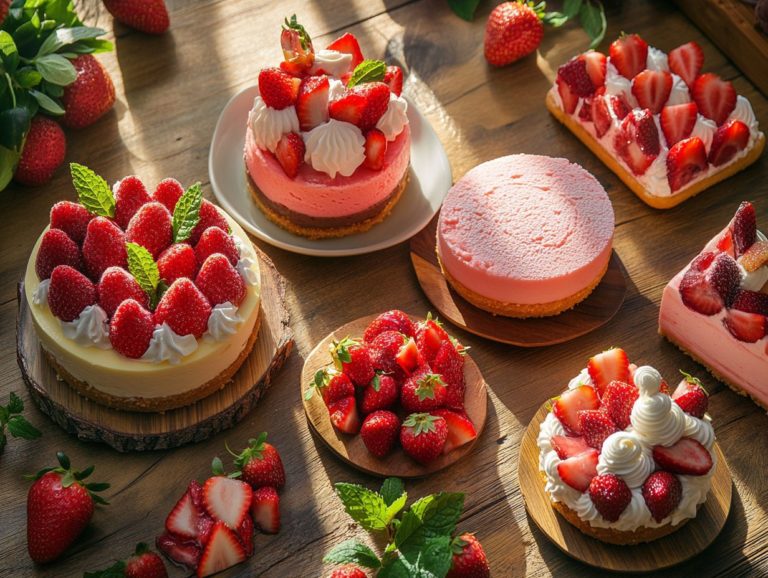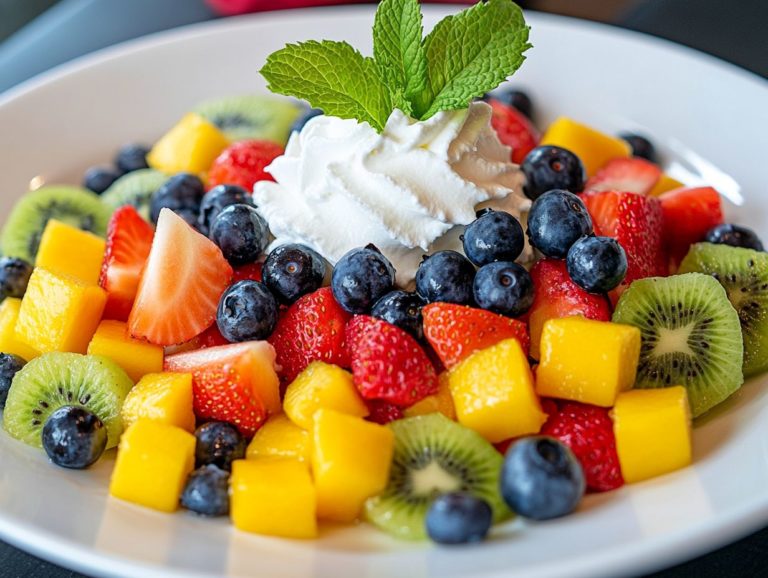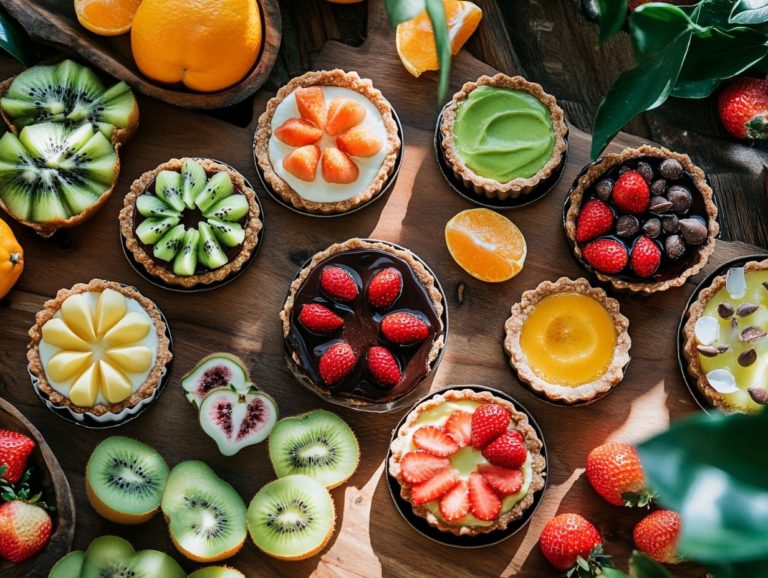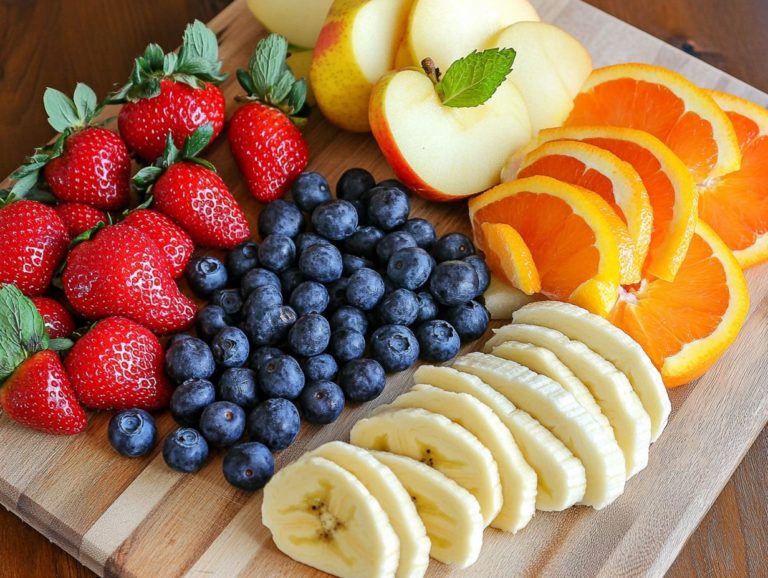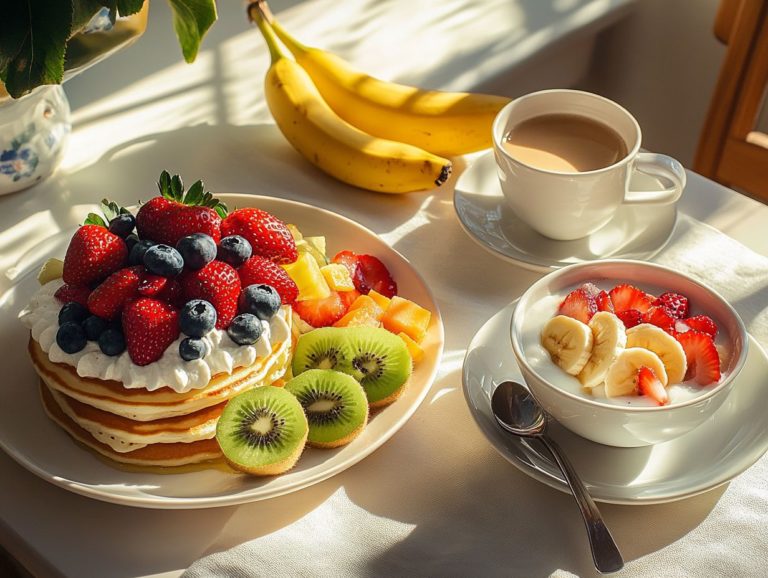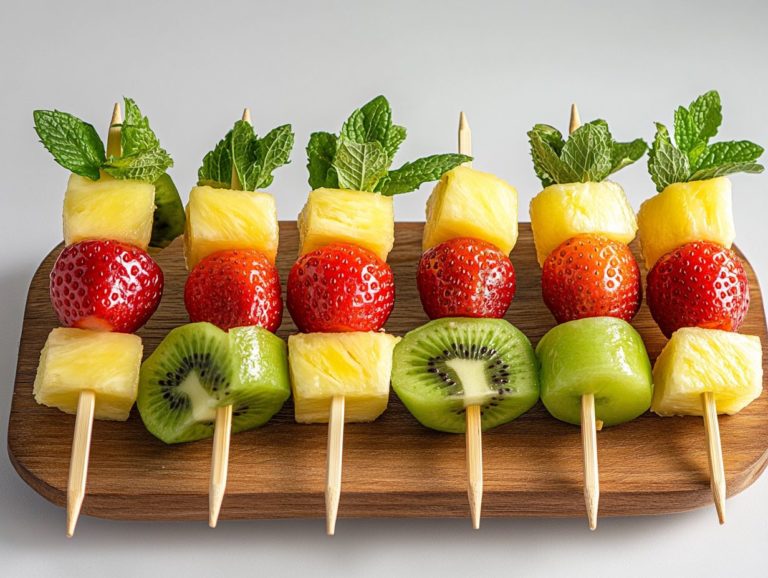How to Make Fruit Leather at Home
Fruit leather is a delightful, chewy snack. It encapsulates the essence of your favorite fruits in a conveniently portable form. This versatile snack is a prime example of how fruit preservation can be both delicious and practical.
If you’re looking to preserve seasonal produce or simply want a healthier treat, making fruit leather at home is an enjoyable and rewarding endeavor. With an easy fruit leather recipe, you can create healthy snacks that cater to your taste.
This guide will delve into the world of fruit leather, outlining what it is, the essential equipment you’ll need, and the best fruits to choose for your creations. You’ll discover the benefits of choosing no added sugar and fresh fruit snacks for your homemade fruit leather.
You’ll also find a step-by-step process for crafting your own fruit leather, plus tips on how to store it and savor its many benefits. By following these fruit leather tips, you can enjoy gluten-free snacks that are both tasty and beneficial.
Prepare to unleash your inner chef and whip up a charming, customizable snack that will impress everyone!
Contents
- Key Takeaways:
- What is Fruit Leather?
- What Equipment Do You Need to Make Fruit Leather?
- What Fruits Can You Use to Make Fruit Leather?
- How to Make Fruit Leather at Home
- 4. Dry the Fruit Leather
- How to Store Fruit Leather
- How to Use Fruit Leather
- What Are the Benefits of Making Fruit Leather at Home?
- 1. Control Over Ingredients
- 2. Cost Savings
- 3. Customizable Flavors
- 4. Long Shelf Life
- Frequently Asked Questions
- How to Make Homemade Fruit Roll-Ups
- What ingredients do I need to make homemade fruit rollups at home?
- Can I use frozen fruit to make fruit leather?
- Do I need special equipment to make gluten-free snacks like fruit leather at home?
- How long does it take to make healthy fruit snacks like fruit leather at home?
- Can I store homemade fruit leather?
- What are some creative flavor combinations for easy fruit leather at home?
- Conclusion
Key Takeaways:
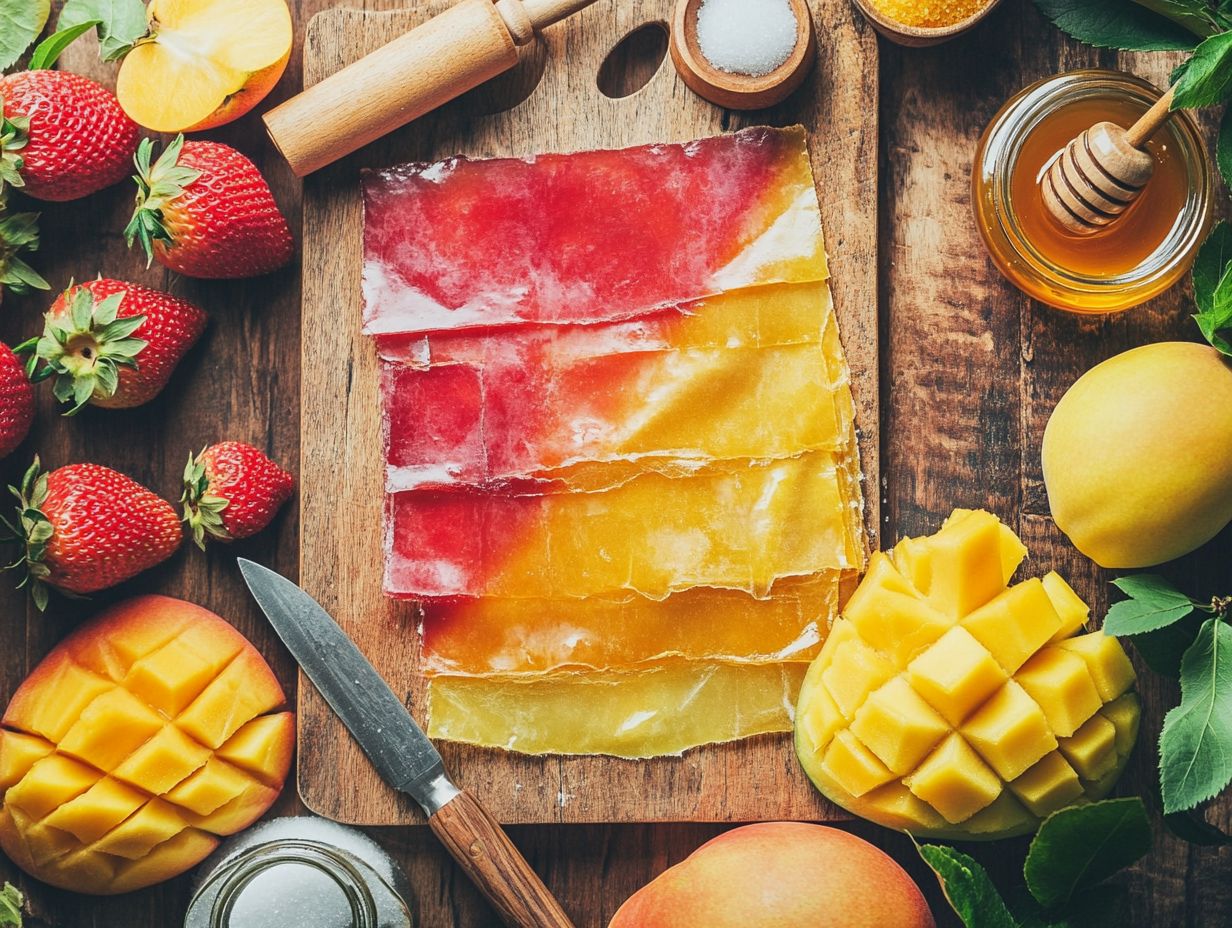
- Use your favorite fruits to make delicious and healthy fruit leather at home.
- All you need is a blender, baking sheet, and oven to create this tasty snack. Using a food processor can also streamline the process, making it quicker and easier.
- Making fruit leather at home allows for control over ingredients, cost savings, and customizable flavors. You can experiment with fruit leather variations to suit your personal preferences.
What is Fruit Leather?
Fruit leather, often known as fruit rollups, stands out as a delightful and healthy snack crafted from pureed fresh fruits that undergo dehydration to achieve that irresistible chewy texture. This method not only preserves the fruit but also offers a convenient way to enjoy its goodness, making it one of the most cherished healthy fruit snacks.
You can effortlessly create this nutritious treat in your own kitchen using a variety of fruits, allowing for a world of customizable flavors all without the need for added sugar. It s the perfect choice for anyone in search of a natural fruit snack that satisfies both taste and health.
What Equipment Do You Need to Make Fruit Leather?
To create your own fruit leather at home, you’ll need a few essential tools: a food processor for pur eing your selected fruits, a dehydrator (a device that removes moisture from food to preserve it) or an oven for the drying process, and a baking sheet lined with parchment paper or a silicone mat to streamline your efforts. These tools are fundamental in making natural fruit leather that is free from added sugar.
The food processor is critical, allowing you to blend your fruits into a silky smooth consistency, ensuring a uniform texture in the final product. Choosing a model with varying speeds can simplify the task, especially when dealing with tougher fruits. A high-quality food processor is a must-have for creating easy fruit leather.
A dehydrator offers a controlled environment that’s perfect for evenly drying the fruit mixture without the risk of baking it, thus preserving all the nutrients. If you decide to use an oven, maintaining low temperatures is crucial; the right heat settings will help you dry the fruit without cooking it. Oven drying is a convenient alternative to a dehydrator for making homemade fruit leather.
The baking sheet also serves as your canvas for the pur e, ensuring an even spread that promotes consistent drying while preventing any unwanted sticking. Lining it with parchment paper or a silicone mat not only makes your cleanup a breeze but also allows you to peel off the finished leather effortlessly.
What Fruits Can You Use to Make Fruit Leather?
In terms of crafting your own fruit leather, you can utilize nearly any fresh fruit at your disposal, allowing you to experiment with an array of flavors and textures. Consider popular choices like:
- strawberries
- mangoes
- blackberries
- raspberries
- peaches
- plums
- apricots
- apples
- kiwis
- bananas
Each of these fruits brings its own distinctive taste to your homemade fruit leather, transforming simple ingredients into delightful, personalized treats. The possibilities are truly endless with the variety of fruit leather ingredients available.
In conclusion, making fruit leather at home not only allows for creativity and customization but also offers a healthy, enjoyable snack that you can feel good about sharing with friends and family.
Discover the delicious world of fruit leather! Let’s explore the best fruits to use for this delightful treat!
1. Berries
Berries like strawberries, blackberries, and raspberries are outstanding choices for crafting fruit leather. They offer vibrant flavors and natural sweetness while being rich in vitamins and antioxidants that enhance a healthy diet.
Their high water content streamlines the drying process, making it simpler to achieve that desired texture and amplifies the flavor intensity as the moisture evaporates. By combining various types of berries, you can create a delightful balance of tartness and sweetness that caters to a wider range of tastes. For example, blending sweet strawberries with the tangy notes of blackberries results in a harmonious treat. A splash of lemon juice adds brightness and prevents excessive sweetness.
To avoid an overly sugary finish, consider adding a splash of lemon juice or incorporating less sweet fruits like apples or pears into your mix. This way, you can achieve a deliciously balanced fruit leather that delights the taste buds without overwhelming them with sweetness. Using honey instead of sugar enhances the natural flavors of the fruits.
2. Apples
Apples are an incredibly versatile fruit for crafting fruit leather, bringing a delightful blend of sweetness and a hint of tartness that pairs beautifully with other fruits. Their natural sugars elevate the overall flavor of your homemade treat.
When exploring different apple varieties, you’ll find that your choice can significantly influence the final flavor profile of your fruit leather. For instance, opting for sweet apples like Fuji or Honeycrisp can yield a richer taste, while the sharper notes of Granny Smith apples can add an interesting twist.
As you prepare your apples, consider adding a splash of lemon juice. This simple addition brightens the flavor and helps preserve the vibrant color of your fruit leather.
To achieve the perfect texture, ensure that the apples are cooked down into a thick puree, which you can then spread evenly on trays for drying fruit. Keeping a close eye on the drying time is essential for attaining that ideal chewy consistency, resulting in a delightful snack that truly showcases the beautiful essence of your chosen apple variety.
3. Mangoes
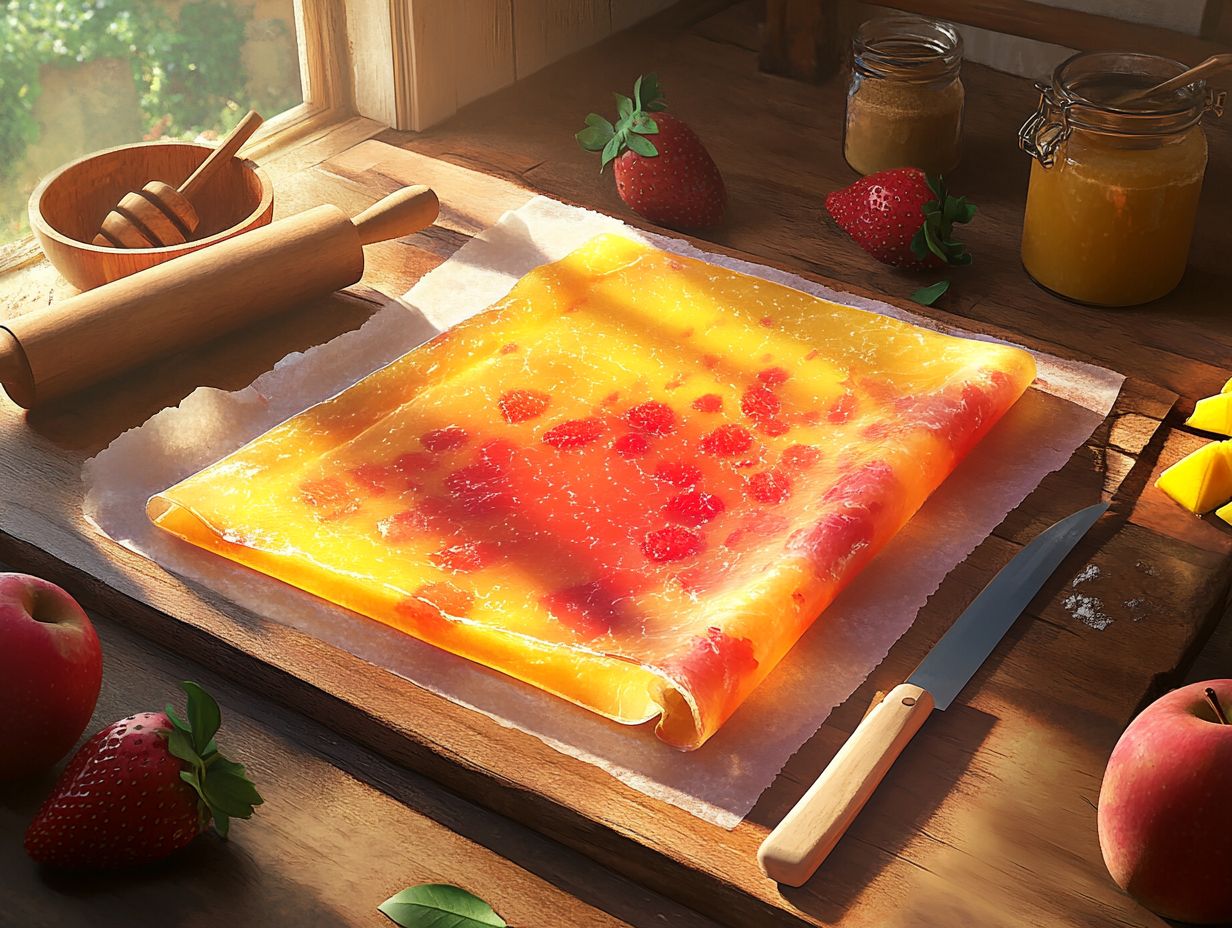
Mangoes infuse a delightful tropical flavor into fruit leather, making them an exceptional choice for those seeking to elevate their healthy snacks with exotic tastes. Their natural sweetness significantly reduces the need for added sugar, allowing the fruit’s inherent charm to take center stage.
With their low acidity, mangoes present a balanced flavor profile that allows them to shine without overwhelming other ingredients. The chewy texture provides a satisfying chew, while their bright color adds an appealing visual element.
In terms of pairing options, consider combining mangoes with fruits like strawberries or bananas; this not only enhances sweetness but also adds depth of flavor, resulting in a harmonious blend that truly delights the palate.
This remarkable versatility positions mangoes as not only a standalone star but also as an outstanding collaborator in creating delicious, nutrient-packed fruit leather. Maya Krampf from Wholesome Yum often highlights mangoes for their unique contribution to healthy snacks.
4. Bananas
Bananas are your go-to choice for making fruit leather, thanks to their creamy texture and natural sweetness. They create a rich and flavorful snack that appeals to both children and adults alike.
When you blend bananas with other fruits like strawberries or mangoes, they enhance the overall smoothness, making the leather even more delightful to eat. To achieve the best flavor and texture, be sure to select ripe bananas those speckled with brown spots promise peak sweetness.
For preparation, simply mash or blend the bananas until smooth, and mix them with your favorite fruits. Dehydrating this mixture will intensify the flavors, resulting in a chewy treat that s perfect for snacking on the go, taking along on hiking adventures, or packing into lunchtime delights. This quick prep snack is a fantastic option for busy individuals seeking healthy choices.
Try these combinations today and make your own delicious fruit leather!
How to Make Fruit Leather at Home
Making fruit leather at home is a fun and delicious project you can enjoy with family! It can be accomplished with just a few straightforward steps.
- First, prepare your choice of fruit, then blend it into a smooth puree.
- Next, spread this vibrant mixture evenly on a baking sheet.
- Finally, you have the option to dehydrate it using a dehydrator or simply rely on your oven for drying.
You’ll end up with delightful and nutritious fruit snacks that your family will love!
1. Prepare the Fruit
Preparing the fruit involves washing and cutting it into smaller pieces. Take care to remove any seeds or pits. You might want to add a splash of lemon juice to enhance the flavor and prevent browning. This can also bring some extra benefits to your homemade fruit leather.
Understanding lemon juice benefits helps in maintaining the freshness and visual appeal of fruit leather. This process is crucial, not just for its visual appeal but also for ensuring that the fruit remains safe and delightful to eat.
When crafting fresh fruit snacks, thorough cleaning is essential to eliminate any pesticides and dirt, giving you a healthier bite.
For fruits like apples and peaches, slicing against the grain will yield a more enjoyable texture. Meanwhile, berries can be left whole or halved, depending on your preference.
Incorporating lemon juice not only brightens the overall taste but acts as a natural preservative, helping to maintain the vibrant colors of your creations.
By embracing these preparation techniques, you elevate your enjoyment of fruit and foster healthier snacking habits. Proper fruit leather storage is also essential to maintain the quality and extend the shelf life of your homemade snacks.
2. Blend the Fruit
Once you ve prepared the fruit, the next step is to blend it into a smooth puree using a food processor. This is essential for achieving a smooth mixture that s free from lumps, which is crucial for the perfect texture in your homemade fruit roll-ups.
Adding Pomona’s Pectin, a natural thickener that helps fruit purees become more spreadable, can assist in thickening the puree, ensuring a consistent spread.
To reach that ideal consistency, you ll want to blend the fruit thoroughly. Start at a low speed and gradually increase to high; this method breaks down the fibers, resulting in a silky puree.
You can enhance the flavor by adding sweeteners like honey or agave syrup, but exercise caution not to over-sweeten the natural sweetness of ripe fruit should be the star of the show.
A splash of lemon juice can also elevate the flavor and act as a natural preservative, ensuring your homemade fruit roll-ups taste delightful while retaining their vibrant color.
3. Spread the Mixture on a Baking Sheet
Once you’ve blended the fruit puree to perfection, spread it evenly onto a baking sheet lined with parchment paper or a silicone mat. This step is crucial for achieving a uniform thickness, which promotes even drying and prevents that dreaded uneven texture in your final fruit leather.
For optimal results, aim for a thickness of about 1/8 inch. This allows for efficient drying without the risk of becoming too brittle. An offset spatula works wonders for smooth and controlled spreading, so make sure you reach the edges of the baking sheet for complete coverage.
If you prefer a different approach, you can pour the puree into the center of the sheet using a small measuring cup and then gently spread it outwards.
As you embark on this drying journey, remember to check the puree regularly. Variations in thickness can lead to inconsistent results, and you want your fruit leather to come out just right.
4. Dry the Fruit Leather

The final step in crafting your fruit leather is the drying process. You can accomplish this using a dehydrator set to the ideal temperature or by opting for a low oven setting. This allows the mixture to dry out completely, resulting in the delightful, chewy texture that defines fruit leather.
When choosing between a dehydrator and an oven, consider how each option influences your final product. Dehydrators are designed just for drying food, offering superior airflow and temperature control. This means you can achieve evenly dried fruit leather without the risk of burning.
Using an oven might take a bit longer and requires your constant attention to avoid over-drying. To assess whether the fruit leather is ready, aim for a flexible texture that feels slightly tacky but isn’t sticky to the touch.
Once your fruit leather has dried to perfection, proper storage becomes essential. Storing it in an airtight container in a cool, dark place helps preserve its freshness for an extended period. This ensures you can enjoy your delicious creation for as long as possible.
How to Store Fruit Leather
Storing fruit leather properly is crucial for preserving its delightful flavor and texture. Once it s fully dried, cut it into strips and roll it up. Then, place it in an airtight container or wrap it in parchment paper to keep it fresh for your future healthy snacks or homemade fruit roll-ups.
For optimal storage, consider using vacuum-sealed bags for extra protection against moisture and air. Both can compromise freshness. If you prefer a simpler approach, a glass or plastic container with a tight-fitting lid works just as effectively.
To prevent your fruit leather pieces from sticking together, sprinkle a small amount of cornstarch or powdered sugar between layers. You can also use parchment paper to separate each roll. This way, you can easily enjoy your healthy fruit snacks without any fuss, all while keeping convenience and flavor top of mind.
How to Use Fruit Leather
Fruit leather is a remarkable addition to your healthy repertoire, offering a spectrum of possibilities. Enjoy it as a quick grab-and-go snack, incorporate it into your lunch boxes, or use it in baking and dessert recipes. Its chewy texture pairs beautifully with a variety of dishes.
Think outside the box and creatively weave fruit leather into your culinary endeavors. Cut it into small pieces and add them to your yogurt or oatmeal for a fruity twist. Variations of fruit leather make delightful toppings for ice cream or can be blended into smoothies, enhancing sweetness and flavor.
If you’re hosting a gathering, elevate your presentation with a stunning cheese and charcuterie board featuring fruit leather alongside an array of nuts and dried fruits. This offers your guests a unique taste experience. The possibilities are truly endless this wholesome treat is sure to jazz up your snack time and mealtime with its delicious sweet and tangy flavors!
What Are the Benefits of Making Fruit Leather at Home?
Making fruit leather at home presents a wealth of advantages. You gain complete control over the ingredients, enabling you to craft a snack that perfectly aligns with your dietary preferences.
You ll also enjoy significant cost savings compared to store-bought varieties. The ability to customize flavors to suit your unique taste is another appealing aspect. Plus, the impressive shelf life transforms it into a convenient and healthy snack choice.
1. Control Over Ingredients
One of the foremost benefits of crafting fruit leather at home is the mastery you gain over the ingredients. This enables you to create a delicious natural fruit leather recipe tailored specifically to your dietary needs. You can avoid the added sugars and preservatives typically lurking in store-bought varieties.
This level of ingredient control brings you peace of mind. It also allows you to make healthier choices, which is especially advantageous if you’re managing dietary restrictions like diabetes or allergies. By choosing fresh, ripe fruits, you can create snacks that are not only delightful but also packed with essential nutrients.
The beauty of this process lies in your ability to customize flavor combinations. You can explore unique creations that align perfectly with your personal preferences options that are both enjoyable and health-conscious. Ultimately, this approach sets the stage for guilt-free indulgence. Each bite of your homemade natural fruit leather is a step toward embracing a more balanced lifestyle.
2. Cost Savings
Making fruit leather at home can lead to substantial cost savings for you. Purchasing fresh fruits in bulk and transforming them into your own homemade fruit roll-ups is often much more economical than shelling out for processed fruit snacks at the store. This makes it a savvy choice for families on a budget.
This method offers a healthier alternative to sugary snacks and sparks creativity in your kitchen. It invites you to experiment with different flavor combinations. When selecting fruits for this delightful project, keep an eye on seasonal options; they tend to be more affordable and bursting with flavor.
For example, during the summer, you can find luscious berries, while autumn brings a bounty of crisp apples. Sourcing these fruits from local farmers’ markets or directly from orchards enhances both the freshness of your ingredients and the savings in your pocket.
By making fruit leather at home, you indulge in a delicious treat while effectively managing your grocery costs.
3. Customizable Flavors

One of the most delightful advantages of making fruit leather at home is the freedom to craft your own unique flavors. Whether you lean toward a zesty mix of berries or a luscious tropical blend of mango and banana, you have the opportunity to experiment with various fruit combinations to perfectly satisfy your cravings.
A simple pinch of cinnamon or a splash of vanilla extract can work wonders. These ingredients enhance the natural sweetness of the fruits and elevate the overall flavor profile. If you’re in the mood for a bit of zing, consider adding citrus juices like lime or orange; they can beautifully balance the sweetness with refreshing acidity.
Incorporating finely chopped nuts or seeds improves the texture and adds a nutritional boost, transforming your homemade snacks into energy-packed delights. This level of flexibility enables you to customize your fruit leathers based on your personal tastes and dietary preferences, ensuring a delightful treat every single time.
4. Long Shelf Life
Fruit leather is a remarkable snack with a long shelf life, especially when stored correctly. This means you can whip up healthy fruit snacks that last for months. It s a savvy choice for meal prepping or stocking up on nutritious treats for your family.
To achieve this impressive longevity, proper storage methods are key. Sealing your dehydrated fruit fruits that have had their moisture removed in airtight containers or vacuum-sealed bags significantly reduces exposure to air and humidity. Placing the fruit leather in a cool, dark spot like your pantry or cupboard further enhances its freshness.
These delightful snacks are incredibly versatile. You can dice them up and mix them into granola, toss them into yogurt, or simply savor them on their own for a quick energy boost. They can even shine as a unique ingredient in your baking, adding a natural sweetness to muffins or energy bars.
Frequently Asked Questions
How to Make Homemade Fruit Roll-Ups
What ingredients do I need to make homemade fruit rollups at home?
To make natural fruit leather at home, you will need:
- Fresh fruit
- Honey
- Lemon juice
- Any additional seasonings or spices you desire
This healthy snack can be easily customized with different fruit rollup ingredients.
Can I use frozen fruit to make fruit leather?
Yes, frozen fruit can be used to make fruit leather. Simply thaw and drain the fruit before using.
This method offers a quick prep snack option for those who don t have fresh fruit on hand.
Do I need special equipment to make gluten-free snacks like fruit leather at home?
No, you do not need any special equipment. A blender, baking sheet, parchment paper, and optionally a silicone mat will be sufficient.
You can also use a food processor or dehydrator for easier preparation.
How long does it take to make healthy fruit snacks like fruit leather at home?
The total time for making fruit leather at home will vary depending on the type of fruit used, but on average it takes about 8-10 hours.
Oven drying is a popular method for making chewy fruit leather.
Can I store homemade fruit leather?
Yes, you can store homemade fruit leather in an airtight container for up to 1 month.
Proper storage is key to maintaining freshness. Using Pomona’s Pectin is a fantastic way to keep your fruit leather fresh and tasty!
What are some creative flavor combinations for easy fruit leather at home?
Some unique flavor combinations for fruit leather at home include:
- Mango and chili
- Strawberry and basil
- Apple and cinnamon
- Blackberries and honey
- Raspberries and lemon juice
Experimenting with different variations can be a fun way to create healthy choices for snacks.
Conclusion
Making homemade fruit roll-ups is a rewarding and delicious way to enjoy a healthy snack. We encourage you to try it out and share your own flavor creations!

